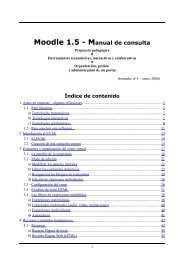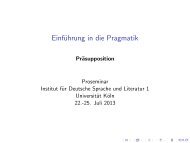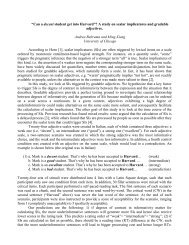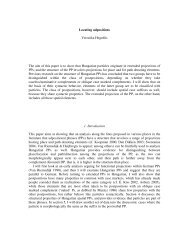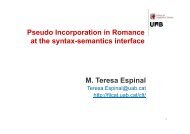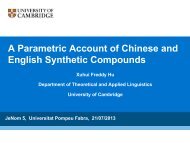Semantic aspects of differential object marking - corpora@parles.upf ...
Semantic aspects of differential object marking - corpora@parles.upf ...
Semantic aspects of differential object marking - corpora@parles.upf ...
Create successful ePaper yourself
Turn your PDF publications into a flip-book with our unique Google optimized e-Paper software.
<strong>Semantic</strong> <strong>aspects</strong> <strong>of</strong> <strong>differential</strong> <strong>object</strong> <strong>marking</strong> 9<br />
ing but rather is a result <strong>of</strong> the use <strong>of</strong> the case marker we do not have to take recourse to such<br />
optionality to explain this pattern. Instead, we can analyze the pattern in terms <strong>of</strong> the speaker<br />
taking into account the perspective <strong>of</strong> the hearer. In case <strong>of</strong> a human direct <strong>object</strong> the speaker<br />
is forced to use ko due to the animacy feature <strong>of</strong> the <strong>object</strong>. In the case <strong>of</strong> a non-human direct<br />
<strong>object</strong> the animacy feature does not require ko and the marker can be used to express the definiteness<br />
<strong>of</strong> the <strong>object</strong>. In this case the speaker has a choice: if he wants to be sure that the hearer<br />
will interpret the direct <strong>object</strong> as definite he has to use ko. If he, on the other hand, does not<br />
want to force a particular interpretation <strong>of</strong> the direct <strong>object</strong>, he can leave it unmarked. Thus,<br />
although on the surface the pattern may look like one involving true optionality, i.e., the speaker<br />
can choose whether or not to use ko on a definite direct <strong>object</strong>, it rather seems to be the case<br />
that the presence or absence <strong>of</strong> ko is the result <strong>of</strong> a principled choice on behalf <strong>of</strong> the speaker to<br />
mark the direct <strong>object</strong> explicitly as definite or not.<br />
Animacy-related case <strong>marking</strong> and definiteness-related case <strong>marking</strong> seem to be instantiations<br />
<strong>of</strong> a more fundamental division among case alternations suggested in de Hoop and Malchukov<br />
(to appear). These authors propose a distinction within the class <strong>of</strong> case alternations between<br />
split and fluid case alternations. In a split case alternation one type <strong>of</strong> noun phrase, e.g., animate<br />
ones, occurs with one case and another type <strong>of</strong> noun phrase, e.g., inanimate ones, occurs with<br />
another case. In a fluid case alternation, on the other hand, the same noun phrase in the same<br />
linguistic context can alternatively take one or the other case marker with a concomitant meaning<br />
difference. For instance, a given noun phrase with accusative case is interpreted as specific<br />
whereas the same noun phrase without the accusative case is interpreted as non-specific. Given<br />
that animacy-related case <strong>marking</strong> represents a split case alternation and that case <strong>marking</strong> related<br />
to definiteness/specificity represents a fluid case alternation, we can conclude that split<br />
case alternations take priority over fluid case alternations. In the next section we discuss why<br />
this should be the case.<br />
4 A Fundamental Difference between Animacy and Definiteness/Specificity<br />
Why should animacy, or a split case alternation, take priority over definiteness, or a fluid case<br />
alternation, in the domain <strong>of</strong> case <strong>marking</strong>? The answer to this question lies in a fundamental<br />
difference between the semantic feature <strong>of</strong> animacy and that <strong>of</strong> definiteness/specificity. Animacy<br />
is an inherent feature <strong>of</strong> noun phrases. Every noun is lexically specified for an animacy<br />
feature and this feature cannot be altered by linguistic structure. If we put case morphology on<br />
an animate noun such as man this does not change it from an animate referring noun into an<br />
inanimate referring noun. Indeed, on a more general note, one has to look very hard in the languages<br />
<strong>of</strong> the world to find something that can be truly labelled as an animacy marker, a piece<br />
<strong>of</strong> morphology that marks and can change the animacy feature <strong>of</strong> a noun. The opposite holds<br />
for definiteness and specificity. Nouns are not inherently specified for definiteness or specificity.<br />
But in many languages there exist linguistic devices which can make a given noun phrase definite<br />
or specific. In English, for instance, the same noun man can be turned into a definite noun<br />
phrase by addition <strong>of</strong> the article the and likewise indefinite by means <strong>of</strong> the article a. English<br />
lacks a pure specificity marker, although the content words certain and particular seem to come<br />
close, but this feature is attributed to nouns and can be changed in context. There are nevertheless<br />
languages which do have dedicated pieces <strong>of</strong> morphology to mark the specificity <strong>of</strong> nouns.<br />
Case <strong>marking</strong> is an <strong>of</strong>ten cited example <strong>of</strong> such a device. Well-known is the case <strong>of</strong> Turkish in<br />
which accusative case on direct <strong>object</strong>s marks them as specific and the same thing holds for embedded<br />
subjects with genitive case (see von Heusinger 2002, von Heusinger and Kornfilt 2005,<br />
and Kornfilt, to appear for detailed discussion). Other languages for which it has been argued<br />
that case <strong>marking</strong> indicates the specificity <strong>of</strong> a noun include Persian (e.g., Karimi 1996) and<br />
606<br />
9




